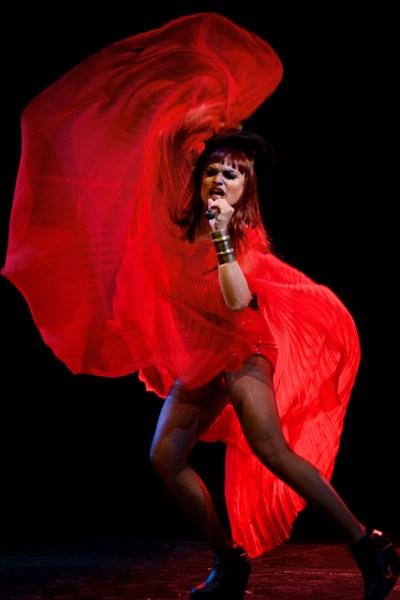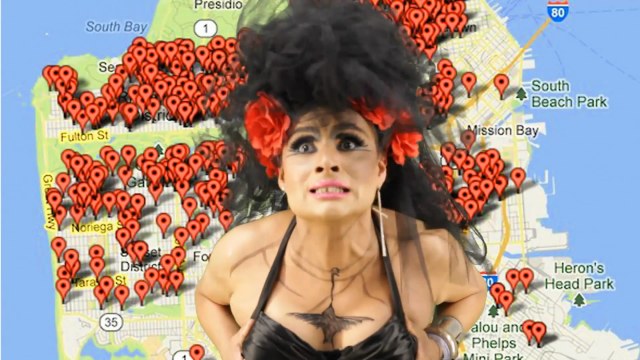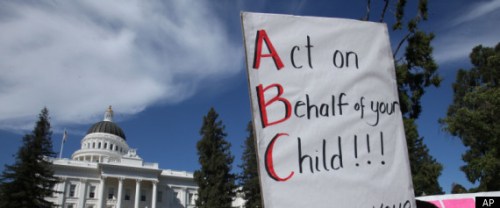Why You Need to Go to Queer Rebels Fest in San Francisco This Weekend
Last year, San Francisco’s Mission District saw the doors of Esta Noche closed for good. The 33 year old queer Latino bar’s closure was dismissed by sites like Eater and the San Francisco Weekly as little more than a drag-show-offering-dive where by mid-afternoon, you could catch “glimpses of dudes blowing other dudes behind open doors.” To the largely queer and trans Latino patrons who populated the bar, it was decidedly more. Through interviews in Juliana Delgado Lopera’s book Cuéntamelo: Oral Histories of LGBT Latino Immigrants, we learn that Esta Noche enabled queer and trans immigrants to find community; it was a place where queer and trans Latinxs could find employment; the bar provided a creative outlet for performers, one of the only in the once predominantly-Latino Mission District to have all-Latinx drag shows.
San Francisco also recently saw the closure of The Lexington Club, the city’s only remaining lesbian bar. When writing of the club’s closure, Lila Thirkield, the Lexington’s owner, wrote about how painful it is to lose queer spaces and much like Esta Noche, it was a matter of no longer being able to afford rent in a rapidly-changing neighborhood.
What we’re really talking about here is violent displacement, also known as gentrification. According to KB Boyce and Celeste Chan, the closure of spaces like Esta Noche and The Lexington Club signify a new stage of gentrification – the loss of public gather spaces for queers and queer and trans people of color.
“With queer and trans people of color (QTPOC), there’s such a history of being pushed out, a sense that we have no place to publicly belong. Even though some can gather privately, there are a lot of QTPOC who are working-class, poor, or homeless, who are pushed from The Piers in NYC or the streets of San Francisco. There is no place to be. We have a presence that is both invisible and policed,” Boyce said.
Boyce and Chan are the people behind Queer Rebels Productions, formed in 2008 with the goal of building artistic spaces for queer and trans artists of color. Since the beginning, the group has wanted to do a multi-ethnic QTPOC festival, like the one they’re holding on May 29 and 30. QUEER REBELS FEST! is the couple’s attempt to move beyond the mourning the QTPOC community so often must do in the face of police brutality and the murders of Black Trans women, women of color, Black women, and Black men. In short, QUEER REBELS FEST! is a reminder of those who are still in San Francisco, holding onto queer and trans people of color artistic spaces. The festival will feature two nights of proactive new performances from queer and trans artists of color, including Ryka Aoki, Wizard Apprentice, South Central-born drag queen Persia, and Elena Rose, among many others.
Queer Rebels first event emerged from Boyce’s performances as TuffNStuff, a cross-dressing Blues musician. After receiving a $500 Queer Cultural Center grant, the group organized/curated Queer Rebels of the Harlem Renaissance for the National Queer Arts Festival. The community really showed up for the event, so Boyce and Chan decided to keep going. The goal now is to be part of a larger QTPOC movement, with Queer Rebels challenging audiences to think about who is honoring queer/trans ancestors and who has artistic freedom, voice, and legacy.
“There aren’t many physical spaces dedicated 24-7 to queer and trans artists of color,” Boyce said. “We exist in the overlap – between queer spaces and people of color spaces. And now all of these spaces are rapidly disappearing. We’re trying to hold it down for queer/trans people of color in San Francisco, be part of a larger movement for QTPOC arts, and also assert our presence is a city that is driving POC out and becoming whiter and wealthier.”
Besides being life-giving, queer and trans art keeps those histories alive. Chan says that so many of the people who are getting pushed out of San Francisco are the ones who helped build the city. Events like Queer Rebels Fest is a way of asserting QTPOC existence, the Queer Rebels co-founder says.
“We’re here on our own terms; we’re not waiting around for the colonial gaze to acknowledge us. In so many spaces, we are pushed out, marginalized – but actually, really, we have a lot of collective power.”
And it’s true: When queer and trans people of color get pushed out of San Francisco, the city also loses.
“Can we be more clear about what makes San Francisco special? It’s that mix of Esta Noche queens, the Hot Boxx girls at Aunt Charlie’s Lounge, Chinese immigrant seniors waiting at the food bank, Folsom Street Fair furries, and guys in assless chaps. It’s the Tamale lady, the now defunct Bay Area Women of Color BDSM Project; it is Rhodessa Jones/Idris Ackamoor making art in the city for 30 years, Mission artists René Yañez and Yolanda Lopez, who were evicted from their home of 35 years, and the Sisters of Perpetual Indulgence. It is the artists, artists, and more artists who make this place special,” Boyce said. “San Francisco has been a hub of communities of color and counterculture. Don’t move to San Francisco, displace people, and then complain about all the homeless people whose displacement you may have perpetuated.”
The sentiment was echoed by Queer Rebels Fest performer Persia (with Daddies Plastik) in an unlikely hit from last summer called “Google Google Apps Apps,” a heavy, yet danceable song about white tech workers who are gentrifying the Bay Area and the Mission, in particular.
What the city doesn’t need, Chan says, is more Google buses.
“What it does need is to make sure that people of color, working-class, queers, trans people, artists, immigrants/refugees, writers, and freaks can still afford to live and work and play here,” Chan says. “It needs to remain a kaleidoscope of culture and history, freaky art, and lefty politics. As Queer Rebels, we’re committed to being here and staying here – and promoting, supporting, and nurturing new work by queer and trans artists of color. Gentrification and economic violence lead to erasure, so we need community now more than ever. We are not leaving. We are fighting for the heart of the city.”

WHAT: Asian Pacific Islander Cultural Center and Queer Cultural Center co-present QUEER REBELS FEST 2015
WHEN: May 29-30, 2015. Doors 7 p.m., Show at 7:30 p.m. $12-25
WHERE: African American Art and Culture Complex, 762 Fulton Street, San Francisco
MORE INFO: WWW.FACEBOOK.COM/QRPRODUCTIONS
Booths for Ladies: An Unauthorized History of the Lexington Club
Sometimes it feels like the bar on the corner of 19th and Lexington could have never existed before 1997, but, of course, it did, serving a working class neighborhood of shifting demographics. And before it was a bar for lesbians, it was a bar for other people and before that it was a meadow near the Mission Dolores. Perhaps it was a stand of curly willows when the land was just for the Ohlone.
When the Lexington Club opened in 1997, I was a very young queer-not-queer, trying to figure it all out in the Mission District. I was easily intimidated by queer women who lived openly. When I went to my first Dyke March in 1996, I was so shocked by topless women cavorting and drinking wine from each other’s navels that I turned around and went home. My first time at Rainbow Grocery, a woman with spiked hair and tattooed knuckles directed me to the aloe vera juice and, overwhelmed with sensation, I immediately knocked over four bottles. And when returning a porn to Good Vibes, I inadvertently slid the VHS cassette (!!) into the wrong slot and the butch storekeeper – gorgeous and terrifying – came out and, flexing a meaty bicep in admonishment, waved her calloused finger in my face and pointed to the correct slot. I might have cried. Everywhere I saw women who were fully and completely autonomous from society’s expectations of being a woman, and it was unlike anything I’d ever seen.
For me, the Lex is where I “re-queer” after being out of town. It is where I have flirted and made out and typed my phone number into the flip phones of beautiful strangers with clumsy drunken fingers. It is where I have sought solace from break-ups, comforted friends after breakups, and encouraged other breakups, celebrated getting good jobs and losing bad ones. The Lex is where I have danced it out after getting catcalled to remember that my body doesn’t belong to anybody else no matter how much I am told otherwise. It is where I once received 33 birthday spankings by my (now ex) girlfriend and the bartender, and then a few years later sat at that exact barstool close-talking with the ladyfag who is now my life partner, before we shared a chaste-but-dangerous taxi ride. Queer space – physical built space demarcated out of the rest of the world – is where I have learned to feel true to my self as a queer with no guarantees of safety in the world. It is where I learned that breaking rules that society has created for women can bring a sense of freedom, and that in being able to reliably show up on a particular doorstep and always find other queers, I have learned to navigate my own rule-breaking.
It also helps that this physical space serves stiff, cheap drinks.
While raising a glass to the Lex with friends a few weeks ago and wondering what the bar would be after the Lex closes (though we can guess Edison bulbs and a cocktail “program”), I realized I never knew exactly what the physical building had been before it was the Lex. The idea of this building housing regular, straight people drinking regular, straight drinks was peculiar to me. So I set off into various archives to learn more, uncovering a total of at least eight proprietors of a tavern at the corner of 19th and Lexington that dates back to 1910. To present my findings, I shall now show you 10 reasons that the building at 3464 19th Street is completely 1000% well-suited to be San Francisco’s most loved dyke bar (sorry, Wild Side West).
1. Hop on a horse with me as we head back in time, to the first moment that the illustrious corner of Nineteenth and Lexington was referenced in the San Francisco Call in 1898.

I’m sure Peters and Waldon were not the last to have wished for a weapon to appear at the corner of 19th and Lexington.
Sometimes it is tough being a lady. And in the late 1890s, it was especially a tough for many reasons, not the least of which is because women had to wear fucking skirts and lengthy dresses that got caught in doors and wagon wheels and that dragged in the mud that was full of turnip tops and fish heads and shit from chamber pots. And the dresses were made with stiff fabric and sometimes had whalebones sewed into them to keep your lustful ladyflesh from jiggling around and arousing suspicion from strange male eyes, even though men of the era were aroused by little more than ankles. I mean, it’s true that women’s bodies are exceptionally gorgeous (another thing I learned at the Lex!), but being forced into non-functional clothing would make anyone want to steal someone’s shot gun and go crazy at the Six Mile House.
2. The French guy who purchased the land and built the building ran a mining company called Log Cabin Quartz and Crevice. Please name the next queer bar Quartz and Crevice. Please.
Louis Begerot (sometimes spelled Bergerat) was a French immigrant to San Francisco who, after the death of his wife, applied for a liquor license and opened a saloon at the corner of 22nd and Sanchez in July 1906, in the storefront underneath his house. The city had been devastated only months prior by the earthquake and Great Conflagration in April 1906, and San Franciscans were eager to return to their normalcy of gambling, drinking, prostitution, and dashing in front of moving streetcars. But some city officials were looking for a fresh start, to impose some order on the newly re-birthed city. At the Police Commissioner meeting where Louis received his liquor license, the police chief emphasized strict rules about liquor licenses, noting that any disputes between police and saloonkeepers would automatically be decided in favor of the police (wow, who’d have guessed that?!).
On July 21 1909, Louis Bergerat started construction on the three-story flats at the corner of 19th and Lexington (the Lex is a Cancer?) and the building was completed on February 26, 1910 (no, wait, the Lex is definitely a Pisces). The building was apparently so noteworthy that a full length photo ran in the newspaper.
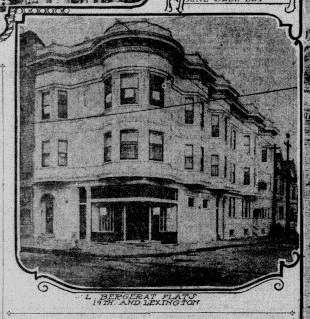
The sidewalks in the photo had just been installed that summer before, as part of a shit-ton of city improvements and construction bonds. Remember, Valencia Street at 19th had been, in 1906, completely and totally fucked by the earthquake. As part of the rebuilding, the Mission District became a destination for working class folks from South of Market who had been made homeless by the earthquake, and so the streets were paved and even more apartments were built.
3. The French guy who owned the land hired a French architect to design the building! So much Frenching at 19th and Lexington!!

First of all, let’s give G.A. Berger a round of applause for designing such a building (with basement! Bonus applause!).
Gabriel A. Berger Jr was the son of a well-known contractor in the city and studied architecture in France. He was with Everett & Berger architecture firm (Oliver Everett is perhaps most known for designing the City Lights Bookstore building but he was also a socialist), and he designed a few other flats in the Mission.
Speaking of Gabriel A. Berger Jr and his story, to be honest, I had a hard time writing some of the historic aspects of the building that houses the Lex, mostly because sometimes when I am digging around in newspapers and genealogical records, I feel like some kind of historical creep, lurking in other people’s business. But then I realized that voyeurism is kind of an essential Lexington experiences. We’ve been in each other’s business there: I’ve seen your breakups, your phases, who you’ve walked around the corner with, who you’ve gone into the basement with. But in trying to maintain historic accuracy, I will not try to read too far into things, and I will definitely not wonder, based on an 1903 article in the San Francisco Call, whether or not Gabriel A. Berger Jr had an affair with a man who was shacked up on his houseboat in Sausalito and who, while taking Gabriel to the ferry, shattered his knee and then passed out in the boat in the tule reeds. I will not fantasize about turn-of-the-century homoeroticism at all.
4. The French guy who designed the building also had a bull terrier puppy named Scout. How many dogs named Scout have you met at the Lex? Or people?
5. Illegal lady drinking!

In 1911, the Mission was apparently rife with vice. The Police Chief had received reports that saloons all over the neighborhood was serving liquor after hours or without serving food, running gambling halls and – shamlessly! – serving women. It is hard for me to fathom this, but during this time, it was actually illegal for women to be in a saloon unescorted, and they couldn’t order their own drinks. Saloons and restaurants in general were challenging for women to navigate, as even when the rules were followed, it was not ladylike for women to be seen in a bar (or even dining) alone. But the police captain of the Mission District clarified that it was not just immoral but illegal (see copies of the captains orders about female patrons in the stunning collection at the San Francisco History Center of the San Francisco Public Library). Captain Henry Gleeson thus sent a detective and ” a lady” undercover out into the Mission on a late Sunday evening, and together they visited 10 saloons. The tavern at 3464 Nineteenth was one of them.
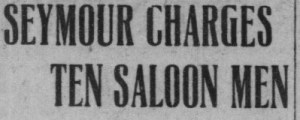
August Pomieczynski was the proprietor of the tavern, and the detective and lady walked right in, ordered liquor at the bar, and drank it. The Call salaciously reported that in each saloon charged, women were in plain sight, just sitting there drinking. Drinking! Liquor! Openly! And talking – sometimes to each other! The reporting – at once breathless and banal – suggests that the women were either prostitutes or didn’t care if they appeared as prostitutes.
Also – the detective and his lady pal (I imagine them kind of like “Moonlighting”) visited 10 saloons in just one evening . And they ended the evening at the Lex! That lady detective is my kind of woman. It was also noted that she ate a sandwich at the one saloon that was operating by the rules and serving food, because, you know, #hangry. And of course, the reports about vice in the Mission all revealed that the police officers in the Mission were profiting from the illegal bunko games (they were in thick with the house, so looked the other way) and several police officers ended up under investigation. But somehow ladies having a Corpse Reviver without a male escort got August Pomiecynski charged with a crime.
6. August Pomieczynski then moved the saloon from 19th and Lexington first to 17th and Castro and then to 18th and Collingwood (right where Toad Hall is now!). There he was later fined $5 for serving “adultered” whiskey. Hats off to you August, you know how to serve people who don’t give a fuck, slutty ladies and bad whiskey drinkers alike.
7. It should be noted that Captain Henry Gleeson, who was in charge of the sting on drinking ladies, ordered a dispersal of a lawful gathering of Socialists after the arrest of anarchist Emma Goldman, who lived on Dolores Street at the time with her lover Alex Berkman. If you have never read Emma’s writings, it is well worth a day spent reading them, especially if it’s a rainy afternoon at the Lexington Club in 1999 and you are 23 and experiencing intense anti-state feels.
8.
![]()
Louis Bergerot died at age 53 in 1913. Mrs. Agnes Moore purchased the saloon in a city auction on May 15th, and was aggressively questioned as to why she — a woman – would want a saloon.
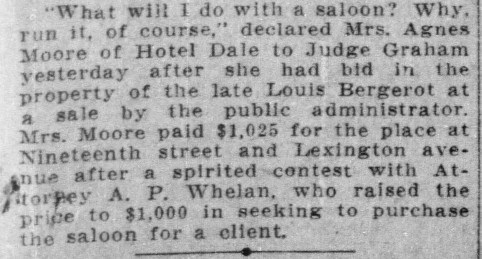
I have not yet found much information on Mrs. Agnes Moore, but the Hotel Dale was a large hotel in the Tenderloin, often hosting union gatherings. It’s not really quite clear why the judge and newspaper reporter were so worked up about a woman running saloon. It was quite common – at least in San Francisco for women to own and run hotels and rooming houses, since that work most closely matched the housework that women were already doing for free in their own homes. And many women ran restaurants and saloons after their husbands were deceased. In fact, in 1912, after August Pomieczynski split, Louis Bergerot got a saloon license for his building by purchasing one from Mrs. Eliza Kramm, who ran a saloon at 957 Mission for a year after her husband died. But our Agnes Moore may have ruffled some manfeathers since she wanted to run the saloon herself, without a dead husband paving the way. Also, how pissed was A.P. Whelan, who probably felt entitled to buy the saloon with his mandollars. Shove it, Whelan!
Also, more Frenching at 19th and Lexington! The city directory from 1914 through 1918 lists a Jules Bonohan (of course the lady who owned the saloon is erased from public records). He was previously a laundryman. Yay for clean sheets!
9. The bar was a “soda fountain” during Prohibition, and given that nice side door, it seems likely that Michael Hannigan, proprietor, was serving ladies moonshine all night long on Lexington Ave. Regarding Prohibition, San Francisco was basically like TL;DR

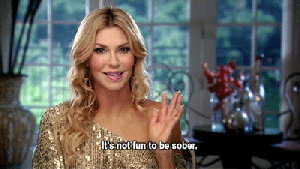






10. By 1933, when Prohibition ended, a Bart Semenza opened the Lexington Buffet, proudly advertising both hot lunch and booths for ladies. God love you, Bart Semenza.

As we saw with August P., serving women openly brings on existential crises for many sectors of society. Outside of formal restaurants, most restaurants were more or less “eating houses” that served food at counters, and they were not always proper for women wanting to preserve their reputation, though of course this differed by race and class. Besides that – a woman eating alone is a big fucking invitation to be asked why you aren’t smiling or to be engaged in non-consensual conversation. I would bet eight thousand double barrel shotguns that a tavern serving women still had men standing around asking ladies if they like dogs or want to see his collection of musical boxes or if she has a beau. So as hangry women started occupying more of the workforce and taking up more public space (and, like, voting) restaurants evolved to serve women who were still wearing the fucking whale-boned skirts and trying to avoid talking to strange men by first adding tables, and then, increasing public invisibility with private dining rooms, booths or boxes, which they kept reserved for women.
So ads like this, ran by proprietor Bartolomew Semenza who, with his wife Mary, ran the Lexington Buffet from 1933 through 1951, were making ladies explicitly welcome by providing them with a proper booth.
ALL YOU CAN EAT AT THE LEXINGTON BUFFET! COME EAT A HOT LUNCH AT THE LEXINGTON! COME QUENCH YOUR THIRST IN A BOOTH AND LET US TAKE CARE OF YOU!
Ok. That was a lot to take in. I kind of need a drink after all of that (hot lunch is tiring; can we get Frenchie to wash the sheets for us?) and because I’m just a lady, so much reading is exhausting…here let me light a cigarette with a — what’s this?
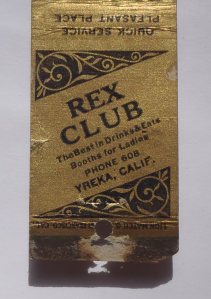
The second half of the decade of 3464 19th is a bit murkier. The bar is listed in telephone directories as the Lexington Club as early as 1960 (did the lighted sign go up then?), and given that the area around the Lex saw more women- and lesbian-owned businesses in the 1970s, I wondered if there was another woman owner in the mix, but there is just one woman listed in directories associated with the Lexington Club, in 1968 through 1971, an Ann Landia T.M. Starr. I can’t find any records for this person, just a T.M. Starr as an arrival to San Francisco on a clipper ship in the 1850s.
Still, I wasn’t looking for the story of a woman bar owner – the Lexington Club has had 18 years with a great woman bar owner. In the historic records, I was looking for stories of queers like myself. Someone who could walk into a saloon and do something that was perhaps immoral or perhaps a reputational risk, and find others who were doing the same thing, and for at least one moment, exhale, have a drink, catch eyes with a friend or a stranger, and feel centered on those geographic coordinates while the rest of the world spins on.
It will be hard without the Lexington Club. But when we walk past the new bar – maybe you’ll go in, maybe you’ll spit in the street, maybe you won’t walk past because the changing Mission isn’t part of your daily geography– we might remember that we made the Lex what it was, but it seems that we also had help from the ghosts of autonomous naughty women, and the men who loved them, that lurk within the walls. Keep your eyes and heart open and maybe we’ll find another building with even naughtier ladyghosts. Let’s raise a glass, or a quartz, to the Lex. Farewell, friend.
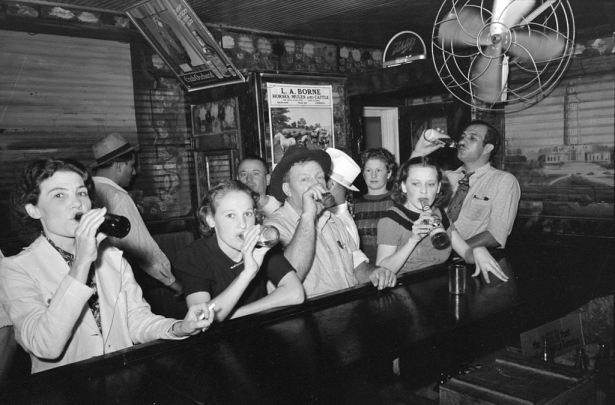
Raceland, Louisiana, 1933. Photo by Russell Lee for Farm Security Administration/WPA.
Originally published on historyparty.wordpress.com. Republished WITH PERMISSION MOTHERF*CKERS.
In 2011, We Won Some Things: 10 Triumphant Moments In LGBT Rights
by riese & rachel
Well, I think just about everyone in the US can agree that 2011 more or less sucked hard States, which I blame on a lot of things including the Republicans in Congress. But anyhow! There’s one group for whom 2011 was not just an endless adventure in suckdom: THE GAYS!

New Yorkers celebrate same-sex marriage (photograph by robin roemer on June 24th, 2011)
I mean, don’t get me wrong, we suffered through some extreme suckage this year. But right now let’s celebrate all the ways in which we won!
Top Ten Things The Gays Won in 2011
10. Prop 8 Is Probably Going to the Supreme Court
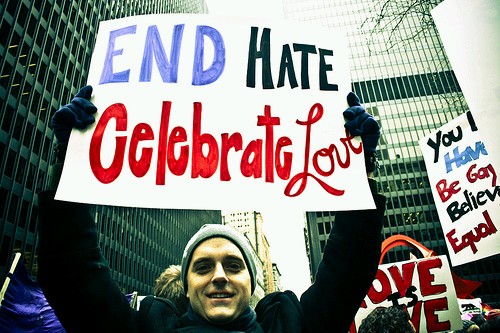
Judge Walker was ruled to be fit to make a decision on Prop 8 despite being gay (revolutionary, I know!) and probably will be again; while weddings still aren’t legal in California, the fact that Prop 8 is likely headed to the Supreme Court could mean that a precedent could soon be set that it’s unconstitutional to ban same-sex marriage anywhere in the US. Combined with the myriad lawsuits against DOMA, and the fact that the Department of Justice has decided to stop defending DOMA against those lawsuits (see below!), 2011 has been full of good developments for marriage equality, and 2012 is looking even better.
9. Gay People Are Everywhere, More Popular
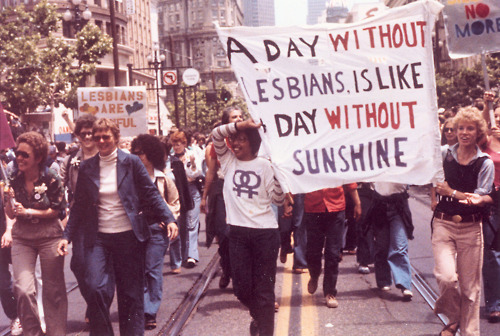
Thanks to census updates, we now have an idea of how many of us there really are: it is a lot, and we are everywhere. The world is changing accordingly; the majority of Republican voters no longer want gay marriage to be an issue. Even Focus on the Family admits they’ve lost the fight on gay marriage. 2011, thy name is progress.
8. Better Healthcare for LGBTQs

2011 was the year in which we saw a future where your doctor might stop assuming you have a boyfriend, and the medical community sort of figured out that your sexual orientation is relevant to your health. The Department of Health and Human Services realized they had to get their act together in regards to the queer community, and the standards of care that inform medical treatment for trans people got a major overhaul.
7. United States Decides “Gay Rights Are Human Rights”
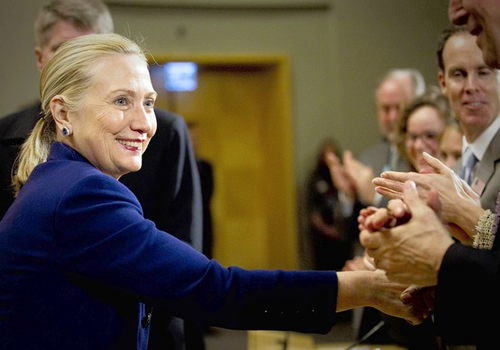
In December, President Obama announced that the US will begin taking into account the experiences and treatment of gays and lesbians in foreign countries when making decisions regarding aid for those nations. Secretary of State Hillary Clinton gave a speech accompanying the announcement, in which she noted (among other things) that “gay rights are human rights.”
6. United Nations Decides LGBT People Deserve Human Rights
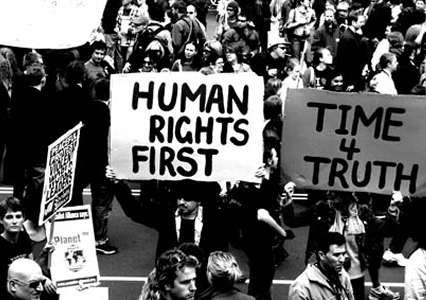
The United Nations, probably totally inspired by Hillary Clinton, released its first formal report on international LGBT human rights. It was 25 entire pages long and is the first-ever UN commissioned study documenting discriminatory laws and practices and acts of violence against individuals based on their sexual orientation and gender identity.
+
5. Obama Suggests Leaving Binational Gay & Lesbian Couples Alone For Now

In an attempt to more efficiently deport people, the Obama Administration orders the Deportation People to not stress about the gay couples right now.
+
4. FAIR SB48 Act Passes in California

California Governor Jerry Brown signed SB-48, the controversial bill which will require California’s public school textbooks to include the contributions of lesbian, gay, bisexual and transgender Americans. Efforts to repeal the bill failed, which means we’re that much closer to a world where American children know more about LGBT history than just what they learned from watching Milk.
+
3. Obama Administration Announces They Are Totally Over DOMA
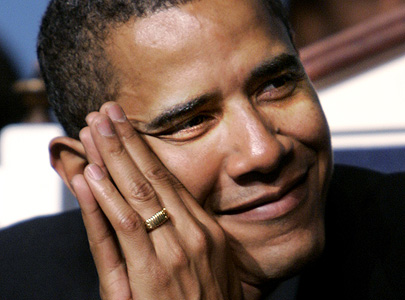
When the Obama Administration declared, kind of out of nowhere, they would no longer defend the Defense Of Marriage Act in court, I actually thought it was April Fools Day.
+
2. Same-sex marriage in New York
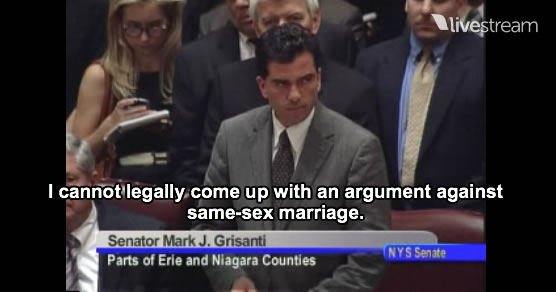
After all kinds of deliberation, the New York State Senate approved same-sex marriage with a vote of 33-29. We were so excited and happy that we partied in the streets, took pictures, cried a lot and listened to that Jay-Z song on repeat for days. We did not, however, forget about pre-nups.
+
1. Don’t Ask Don’t Tell Repealed

PETTY OFFICER 2ND CLASS MARISSA GAETA, LEFT, KISSES HER GIRLFRIEND, PETTY OFFICER 3RD CLASS CITLALIC SNELL, AT LITTLE CREEK IN VIRGINIA BEACH ON WEDNESDAY, DEC. 22, 2011 (BRIAN CLARK | THE VIRGINIAN-PILOT)
This year we charged John McCain’s giant asshole blocking our path to freedom and successfully overturned “Don’t Ask Don’t Tell,” which required gay soliders to keep their gayness a secret. The end of DADT meant that this adorable lesbian couple were able to have the first homecoming kiss in front of literally the entire world.
Effort to Repeal California Gay History in Schools Officially Fails
Back in July, California officially passed SB 48, a bill which required the state of California to include the contributions of gay, lesbian, bisexual and transgender people to our nations in its textbooks. Since California is the biggest market share of textbook buyers of any US state; this is a big deal; it could significantly influence the curriculum in textbooks nationwide. Of course, initiatives to reverse the bill’s passage started immediately — but repeal efforts faced an uphill battle. As of Wednesday, the repeal of SB 48 has finally failed.
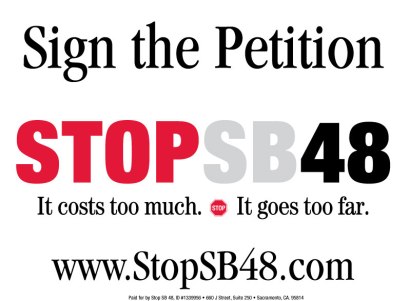
Groups that opposed SB 48 were circulating a signature intended to demand a vote on the bill and call for its repeal. They needed 505,000 signatures by Wednesday, and they didn’t have them. Even more telling as far as how unfeasible a repeal apparently was, “Traditional Values Coalition spokesman Benjamin Lopez earlier said the groups had decided not to file regardless of whether they reached the threshold.” That doesn’t mean everyone’s given up, however. Some are convinced that the petition was effective in sending a message, if not actually accomplishing what it set out to do.
Brad Dacus with the Pacific Justice Institute, which spearheaded the ‘Stop SB 48’ campaign, says whether they rounded up enough signatures or not — it won’t stop their efforts. “We’re convinced that this sends a loud signal to the legislators in California that if they’re going to adopt this kind of anti-parent, anti-family legislation, they can expect to hear about it one way or the other,” said Dacus.
The plan now seems to be to punish Democratic legislators for passing the bill the next time they’re up for reelection, bringing up the issue in terms of a lack of family values and “respect for parents” as a vote draws nearer. At the same time, some are planning to go back to the drawing board with a petition strategy, creating a ballot proposition that would deal in general with children being taught curriculum of any kind in school that their parents didn’t endorse. (Although California has a law that ballot initiatives have to stick to a single subject, so that might be tricky.)
It’s a nice coda to what’s really a pretty long story. In 2008, Prop 8 passed in large part because voters were goaded into a misguided fear that legal same-sex marriage would somehow lead to “gay marriage being taught in schools.” In 2011, a law is passed that confirms those fears as much as any actual real-world legislation will, and its most vitriolic opponents can’t manage to drum up even a full petition to try to oppose it. Having SB 48’s safety won’t fix everything, and it can’t ensure safety at school for queer kids or respect for their families. But for queer kids in California and maybe across the nation, it can at least give them something to be proud of.
Anti-Gays Find “Repealing CA’s Gay History Mandate” Quite Challenging, Not an Easy A
California serves more pupils than any other state in the nation and does so with the lowest per-student expenditure in the country — about $9,000 per student on average, significantly less than states with similar costs of living such as New Jersey and New York, who spend approximately $17,000 per student. California is also one of the most unequal states in the country for education resources distribution, with poor schools often getting by on $6,000 per pupil while richer areas support up to $20,000 per student. Teachers’ salaries similarly vary at a 3 to 1 ratio around the state, with low-salaried teachers more likely to be serving low-income students, students of color and English-language learners. California is amongst the three most segregated states for Latino students. Some of the poorest districts operate with up to 50 percent uncredentialed teachers and astronomical staff turnover rates. California is the only state in the country who hires principals and special ed teachers who lack experience or preparation.
California also ranks amongst the nation’s lowest for academic achievement and in the bottom ten percent for class size, staff/pupil ratio and library quality. Almost one-third of California’s ninth grade students drop out before high school graduation.
With all those concerns facing the parents of California’s schoolchildren, it’s hard to know where to begin. Education activists are undoubtedly working hard to fix California’s system, but where should we ordinary citizens be devoting our advocacy and attention? What issues really matter most?

Well, according to several major advocacy groups in the region, we should all be turning our most critical eye to SB-48, a law passed this year which would add “LGBT people” to the list of minority groups California schools are expected to include in its social studies curriculum.
We first told you about the effort to overturn SB-48 back in July. Over the past few weeks, Stop SB48 has been amping up their campaign and pro-equality groups have been weighing in on the probability of their success. For starters, here’s one of Stop SB48‘s new PSAs:
Yes, it’s that same old song again! According to leading groups who allegedly do things like “focus on the family,” “protect kids” and “preserve marriage,” SB-48 will turn children into red-hot flaming homosexuals who kiss their first cousins in chicken coops. These groups also claim SB-48 will cost taxpayers extra money, because it takes special ink to write LGBT people’s names and textbooks weigh more when they have LGBT people in them.
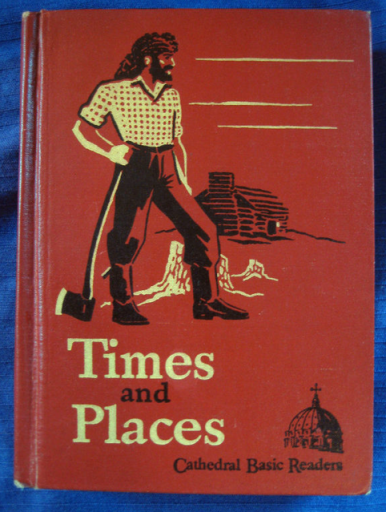
Think about how much simpler this all was two hundred years ago, when the only thing anyone could learn in history books were the achievements of straight white men who wore wigs and shot people with rifles! Those books were so cheap to make! It was like making a pamphlet, basically.
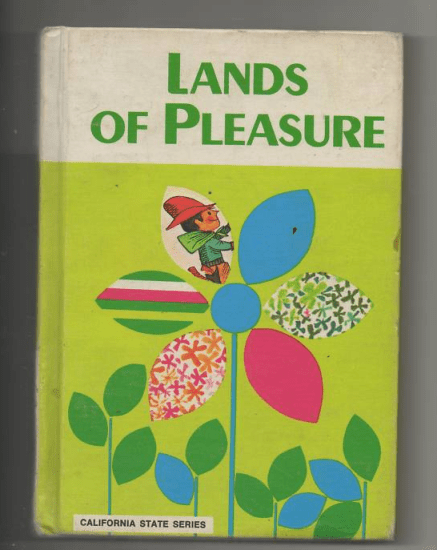
Ladies and gentlemen, The Protect Kids Foundation:
California Senate Bill number 48, now tracking its way through the legislature, would change the teaching of core academic subjects into a “celebration” of gay, lesbian, transgender and bisexual lifestyles. This profound change in the basic education of children would be mandatory, without involvement or opt-out rights of parents.
Next up we have ConcernedParentsUnited.com. What do you think SB-48 will do, Concerned Parents? Is it:
+ Violate the innocence of 9 million California children, starting as young as kindergarten.
+ Borders on psychological abuse by promoting gender confusion, experimentation, and undermining rightful parental authority.
+ Sexualizes all school materials unnecessarily.
+ Normalizes homosexuality, bisexuality and transgenderism, still Gender Identity Disorder by the APA.
+ Omits known dangers of homosexual lifestyle — especially for men who have sex with men.
Yikes! Stop SB48 also mentions to its followers that “children as young as five” will be taught to not only “accept” but to “endorse” homosexuality, bisexuality and “transgenderism.” This could lead to dangerous side effects like unity, empathy, and kindness.
Family Research Council’s friend-of-the-KKK president Tony Perkins is starring in PSAs on the subject, to which Equality California has released this reaction video (which falls a bit flat in my opinion):
[yframe url=’https://www.youtube.com/watch?v=jiQ96NNRLwY’]
However, last week the director of Equality California, Roland Palencia, said if a repeal was on the ballot, we’d probably lose. Specifically:“the prospects are not good if this gets to the ballot. I am not under any illusion.” He pointed out that “this is the seminal, core issue they always get us for, so they have the advantage on this so far” — which was my first reaction, too. I mean, they basically campaigned for Prop 8 by arguing against SB-48, even though at that point it didn’t exist!
EQCA’s communications director, Rebekhah Orr, told journalist Rex Wokner that EQCA’s strategy for fighting against the HSB48rs is to paint the group as “the extremists that they are.” She also points out that Stop SB-48 is using “the same sound bites they’ve been playing for 20 years” but “we have no illusions about the monumental task before us… we’re going to need to do much more robust pieces of research, and we will not be able to say anything definitive, certainly, until we’re done with that.”

But what’s the reality of the Stop SB-48 movement on the ground? Well, the effort to Restore the Heterosexual Innocence of America’s Most Precious Moments Initiative is hitting some snags in their mission to raise anti-gay awareness and collect 504,760 signatures before October 12th, thus nailing the SB 48 referendum a spot on next year’s ballot:
….so far, Mormon and Catholic church leaders and conservative groups who spearheaded the Proposition 8 campaign have not joined the effort to qualify the gay history referendum for the June 2012 ballot, leaving less-experienced Christian conservatives to lead the charge without the organizational prowess and funding to hire paid signature gatherers.
Political operatives say they can’t recall any citizens’ initiative that made the state ballot without professional petition circulators in almost three decades.
“If someone wrote a million-dollar check, we would be guaranteed to get this on the ballot,” said Pacific Justice Institute President Brad Dacus, whose legal aid firm wrote the proposed measure and is co-sponsoring the signature-gathering effort. “That’s not the case at this point… We are counting on people in churches and communities and families making the extra effort to get it done.”
If Stop SB48 doesn’t manage to get the referendum on the ballot, that would be in line with some recent developments on The Other Team’s side – like that NOM’s campaign to raise $100,000 has failed and that a new study shows that many Millennial Evangelicals support same-sex marriage.
Why the lack of support for Stop SB48? Well, anti-gays haven’t ever had a problem with devoting excessive resources to legal issues which have no actual tangible impact on themselves at all, but it’s worth mentioning that the Evangelicals who generally support these campaigns — the denominations with the strongest anti-homosexual views are Evangelical Protestants, Jehovah’s Witnesses and Mormons – are notorious for not enrolling their kids in public school to begin with (18% of Californians are Evangelicals — the second-most represented religion in California after Catholicism — but only 2% are Mormon or Jehovah’s Witnesses).
As far back as 2002, Focus on the Family’s founder James Dobson told his followers during a Focus on the Family Broadcast:
“I’ve been on the air here with Focus on the Family for 25 years; it’s the first time I’ve said this. But in the State of California and places that have moved in the direction that they’ve gone with the schools, if I had a child there, I wouldn’t put that youngster in the public schools… I think it’s time to get our kids out.”
That same year, on The Sean Hannity Show:
“I said let me simply say, not for everybody, but if it were my child in California, where they’re teaching homosexual propaganda, starting with kindergarten, 5-year-old children sitting on the floor, hearing about adult perverse behavior, I would get my kid out of there.”
“Same sound bites they’ve been playing for 20 years”? Check!
When Proposition 82, the “preschool for all” initiative, hit the ballots in 2006, the far-right trotted out similar arguments about the “far-leftism” of public schools and the importance of separating School from The State. It is estimated that some 75% of homeschooled children are of the Evangelical tradition (which, sidenote, is sometimes problematic for non-denominational homeschoolers just looking for accurate textbooks to use with their children).

probably no gay history in this textbook
In fact, when The Pacific Justice Institute isn’t arguing against SB-48, they’re pushing for homeschooling rights. Furthermore, the “education” section of Focus on the Family‘s website doesn’t mention SB-48 — it’s focused on “school choice” advocacy, a.k.a. the rights of parents to take their kids out of public schools that allegedly support homosexual agendas. Focus on the Family’s California chapter isn’t blasting anything about SB-48 on its front page, either. The Family Research Council supports Stop SB-48, but devotes its webspace to economic issues, something involving Netflix and Walgreens, and allowing clergy to participate in the 9-11 memorial.
Is it possible that Stop SB-48 is suffering from The Boy Who Cried Wolf syndrome? Perhaps after years and years of those same sound bites, it’s difficult for even Stop SB-48’s potential fundraising base to see how this round of homosexual indoctrination is any different than the billion that allegedly came before it. Parents who heeded Dobson’s call in 2002 and in 2006 to pull their kids from public schools have already taken action, after all. The deal with their relationship to CA’s education system was sealed far before SB-48 came along.
Sacramento political Consultant Wayne Johnson, who has extensive experience with ballot initiative campaigns, told Forbes.com that “with the same-sex marriage ban tied up in the courts, a presidential election on the horizon and many Christian parents with children in private schools, conservative groups with the most cash and experience may sit out this fight.”
At the end of the day, SB-48 is one of the few positive steps California has been able to make towards a more supportive, inclusive and progressive public school system. Next up? Let’s try to ensure that every pupil in California gets a new textbook at all:
When California kids go back to public school this year, most will have old textbooks. In fact, the state won’t even order any new ones at least until 2014, thanks to budget cuts.
“We’re talking about five years here. For school-aged children, five years is a long time. Today’s fourth grader will be entering high school in five years,” said public school lobbyist Peter Birdsall.
The budget cuts to education are so deep, Sacramento is allowing school districts to use this year’s $330 million earmarked for textbooks to pay for other things.
Now that’s what I call a crisis for California’s schoolchildren.
‘Stop SB 48’ Campaign Doesn’t Want US History Books to Tell the Truth
My first college course was History of American Women. It proved to be a powerful experience. I dug through primary sources and wrote research papers. I voted for Hillary Clinton. I cried when she conceded (for a while). I became a women’s studies minor, and then a women’s studies major. I began to seek work on various feminist topics and made contributions in my community, and internationally, to women’s rights.
This one history course changed my entire life. It inspired me, but it also bewildered me. Why had nobody mentioned these women to me before?
I want to paint rainbows inside of every textbook. I want every history lesson to be about someone like you. Because it’s impossible that American history lacks a gay person. So why not learn from them?

what if every lesson was just a little bit gayer? Or, a little more accurately representative of gay people?
This question is more important than ever in California, where SB 48, a bill requiring California public school textbooks to include the contributions of LGBT Americans, is facing opposition. The bill was signed by Governor Jerry Brown just two weeks ago, freeing countless stories that had previously been silenced and untold. The true narrative of our country. The entire epic. Starring everyone. Even someone like you.
We’ve been following SB 48 since April because it’s a huge deal. Two important notes:
+ The bill may help undo some of the damage of Texas’ pretty much opposite standpoint on textbooks. (Texas has a very conservative approach and set of standards.) The two states are the biggest textbook markets in America and, with SB 48, one of them will be inclusive of LGBT peoples.
+ Because California is the ultimate, largest, totally biggest market for textbooks, though, this bill will have a large impact on the rest of the country, period. Texas or not.
History helps us to gain a cultural and social understanding of our world. It provides us with a context for our life experiences, and it’s a guidebook for the future. What’s been done? What hasn’t? What should have happened? Why did they produce Sex and the City 2? These are important questions. History can answer many of them.
But Stop SB 48, a campaign being run by “a coalition of pro-family organizations, parents, students, teachers, and more,” is hoping to repeal the law in California, citing that SB 48 “undermines the traditional family” by forcing children to “study materials that tell them their families’ values are wrong.”
The campaign’s stance that SB 48 is “fiscally and academically irresponsible” is especially special:
+ It forces schools to review and replace their curriculum at a time when this money should be used for other purposes.
+ It requires a selective treatment of history by requiring that only events that reflect positively on people in the LGBT community may be discussed.
Basically they want to pretend that you don’t exist and never have. They want to rewrite history. Again.
Stop SB 48 is already on the web and Facebook, and has recently filed paperwork to start the petition drive for a ballot measure. If they receive 504,760 signatures, they’ll be adding a ballot measure in the upcoming elections this November.
Regardless of the rhetoric, Stop SB 48 is, of course, not actually attempting to “protect” or “preserve” our history, but to ruin it. Traditional American history textbooks have always told the story of someone else. Not me. Not people of color, not women, not queers — someone else. Not only is this alienating, it’s also wholly inaccurate — a fact I hadn’t necessarily grasped until that life-changing history course. SB 48 is important because the history of LGBT Americans is not “gay history,” it’s American history. It’s a full, uncensored, narrative of our country and the truth about who created it — at every step and in every way. I want everyone to know who raised hell, who didn’t, and who waited until the last minute.
It’s our history and it deserves to be saved.
CA Gov Signs LGBT School Textbook Bill, Making California Textbooks Opposite of Texas Textbooks

getty images model reading a book about gay people (probably)
California Governor Jerry Brown signed into law today SB 48, the controversial bill which will require California’s public school textbooks to include the contributions of lesbian, gay, bisexual and transgender Americans. This is a big deal that we’ve been discussing for a while now as we’d all like to imagine a world where everyday Americans know more about gay history than what was covered in Milk. It’s an even bigger deal because, as we talked about last week, California makes up 13% of the textbook market which is the largest market share of any individual state. Does this mean that “as goes California, so goes the nation?” Maybe. More on that in a minute.
Governor Jerry Brown‘s statement on the historic bill:
“History should be honest. This bill revises existing laws that prohibit discrimination in education and ensures that the important contributions of Americans from all backgrounds and walks of life are included in our history books. It represents an important step forward for our state, and I thank Sen. Leno for his hard work on this historic legislation.”
Mark Leno, the Senator who introduced the bill, had this to say about it:
“This will benefit all students by better informing them of the civil rights movement of the LGBT community. Denying them the fact of this historical chapter denies students a better understanding of their fellow classmates who may be a part of this community.”
This is hardly the first measure passed to require inclusion of minority groups in public school textbooks. The SF Gate reports: “By signing the measure, the governor adds LGBT Americans, along with disabled Americans and Pacific Islanders, to an existing list of groups that must be included in social studies instruction.”
However, the inclusion of disabled Americans and Pacific Islanders represents really only a fraction of the numerous diversity requirements imposed upon textbook manufacturers, at least in California.
See, on the other end of the ideological spectrum we have Texas, the second-largest textbook market after California. In March 2010, the Texas Board of Education “approved a social studies curriculum that will put a conservative stamp on history and economics textbooks, stressing the superiority of American capitalism, questioning the Founding Fathers’ commitment to a purely secular government and presenting Republican political philosophies in a more positive light.”
Renowned educator Diane Ravitch wrote in The Daily Beast following that decision in Texas:
Given the strong conservative hold on the elected state board in Texas, it is not surprising that the board demands that its textbooks are patriotic and respectful of religion. Given the strong liberal character of California politics, it is not surprising that its state guidelines demand equal time and respectful representation of gender groups, ethnic and racial groups, and all minorities.
In 2006, The Wall Street Journal did a feature story about the guidelines for diversity in textbook imagery, which framed these requirements as reflecting “censorship” and “political correctness gone awry”:
McGraw-Hill’s guidelines for elementary and high school texts require the following: 40% of people depicted should be white, 30% Hispanic, 20% African-American, 7% Asian and 3% Native American. Of that total, 5% should be disabled and 5% over the age of 55. The Harcourt Education unit of Reed Elsevier PLC requires its elementary textbooks to include about 50% whites, 22% African-Americans, 20% Hispanics, 5% Asians and 5% Native Americans as well as 3% disabled.
The Journal also concluded that “the purchasing decisions of these major customers (California, Texas and Florida) can make or break a textbook. California, which is 35% Hispanic, is the nation’s biggest market and its adoption process sets the pace for the country.”
These liberally-associated “political correct” mandates have drawn their fair share of criticism (issues around Muslim representation in school textbooks, for example, have been particularly heated), some warranted and some not.
Back in 2003, many critics were already up in arms about new standards of political correctness for textbooks which allegedly prohibited things like depicting African-Americans as story villains, American Indians with long braids, men as lawyers/doctors or women as doing household chores. At that time, Sue Stickel, the deputy superindendent for curriculum and instruction at the California Department of Education said:
“I think our textbooks should, to our greatest capacity, be free of any type of stereotyping. We need to make sure that all ethnicities are represented. We need to make sure that both males and females are represented. We need to make sure that our materials cover the full gamut.”
Despite cries of censorship, Fox reported that “textbook publishers admit they are in a bind. They say if they don’t adopt the changes made by large states like California and Texas, they would suffer severe economic consequences.”
So which way will the country go? Will California set the new standard, or Texas?
Both initiatives are ostensibly pursuing the same standard – ensuring that the material our children learn about the world from represents The Truth About America. The real issue here is of course, as always, that no one can agree on what that truth is. It seems safe to guess that to the people involved in textbook curriculum in the state of Texas, the most “honest” history of America really is one of patriotic values and Christian principles bringing democracy into the world, and that the alternate story about our nation’s founding that includes imperialism and genocide just isn’t the way it happened. They want their kids to learn the real deal, not a “fabricated PC version” – which is what this bill in California really does seem like to them. That’s why opponents have called the bill “absurd” and “indoctrination” and claimed it’s an attempt to lure children towards homosexuality – because when you truly don’t believe this version of history is real, there doesn’t appear to be another explanation.
And that’s what the big deal is – for most of our nation’s history, that stance was virtually unanimous. It’s huge that gay kids will finally be able to see that they have a lot of incredible predecessors, and that straight kids will learn that gay people both exist and are deserving of respect.
But it’s also huge that there are people who have worked to make this happen – who have stood up to say that this is the truth about our nation, that gay people and their contributions to our culture are part of the real America, and that it’s important to acknowledge it. It reflects a shift that’s about more than just educational policy; it means that people are now seeing something that for most of history they fought to avoid having to look at, and that something is us.
Why Gay History Could Make History In California
Back in April, bill SB-48 was introduced in California; it would require standard curriculum to include education about gay and lesbian role models in social science textbooks. Now, months later, it’s passed the State Assembly and California Governor Jerry Brown has 12 days to either sign or veto it.
Of course, like anything involving queers in the school system, the bill is the subject of much controversy. Its opponents claim that it’s dangerous material for children to be exposed to:
Assemblyman Tim Donnelly, a Republican from Twin Peaks, said he was offended as a Christian that the bill was being used to promote a “homosexual agenda” in public schools. “I think it’s one thing to say that we should be tolerant,” Donnelly said. “It is something else altogether to say that my children are going to be taught that this lifestyle is good.”
Supporters of the bill appear to be more offended as human beings that so many gay kids in schools all over the country are killing themselves, a problem that really can get a lot better with more measures like this. When kids see themselves reflected in reality around them, they’re less likely to want to disappear; when straight kids see that gay people have had a huge impact on our nation’s history, they’re less likely to torture their peers.
There’s also the factor that – as we talked about back in April – California is basically the most important state this could possibly be happening in. Despite being only 2% of the states in the union and roughly 12% of the US population, California made up 13% of the US textbook market in 2009, and had at least 6.2 million children in public school. The buying power of the state of California can easily influence the content that gets put into textbooks that will end up being purchased all over America. California has been the site of several groundbreaking and progressive new achievements for queers, and especially queer kids – for instance, LA County is the pioneer of a multimillion dollar pilot program aimed at supporting homeless gay youth. California’s size and influence give supporters of these measures hope that they are more likely to happen in other states, as well.
California is facing a major budget problem, though, and so far much of Brown’s time as governor has been spent trying to close the gap. California is still reeling from the budget crisis that occurred during Schwarzenegger’s time as governor. SB-48 would require California schools to include this educational material in their curriculum as soon as the 2013-2014 school year; for a governor whose only hope of success is tightly controlling spending, passing SB-48 is a serious test of where his priorities lie. Opponents of the bill will likely criticize it as an unjustifiable expense during the 12 days of heavy lobbying on both sides that is certain up ahead.
It’s also interesting that this battle is going down in California for another reason – school curriculum was a major issue in the vote on Prop 8, even if it was a totally misinformed controversy. Part of Protect Marriage’s campaign for Prop 8 in California was the insistence that without it, children would be “taught gay marriage” in schools. Prop 8 opponents derided this as a scare tactic and distraction from the real issue; this was accurate, as there was no language whatsoever in the bill on same-sex marriage in California about school curriculums. Their only ammunition was a single lawsuit in Massachusetts, where marriage has been legal since 2004, in which one pair of parents was upset that their child was read a book about two princes getting married in the classroom. The book and the lawsuit were completely unrelated to marriage equality, and the lawsuit was dismissed, and subsequent appeals have failed. That didn’t dissuade people like this gentleman, however. Nor did it stop Protect Marriage from running this charming PSA, either:
[yframe url=’https://www.youtube.com/watch?v=7352ZVMKBQM’]
The progress of SB-48 three years later has no direct link to Proposition 8, but it does seem ironic that same-sex marriage still isn’t possible for Californian couples while a major part of the reason it was denied to them may become a reality.
There’s no word on how Governor Brown will vote; his office has given no comment one way or the other. Brown is a Democrat who was supported by Equality California during the gubernatorial election; EQCA has met with him twice now to urge him to pass the bill. It passed the Assembly 49-25, a fairly large margin, but a similar bill was vetoed by (Republican) Governor Schwarzenegger in 2006. This time the bill is championed by a number of openly gay lawmakers and California officials – for instance, Assembly Speaker John A. Perez, or Assemblyman Tom Ammiano, who says that “I don’t want to be invisible in a textbook.” Hopefully, their voices will be heard, so that children across the state (and maybe eventually the country) can hear their own stories told.
California Schoolkids, Adam Lambert Are Winners This Sunday Funday
CALIFORNIA:
Seemingly against all odds, the bill that would require social studies curriculum in the state of California to include gay history and role models is moving closer to becoming a reality. This week it passed the state Senate, and now heads to the general assembly, where it is widely expected to pass.
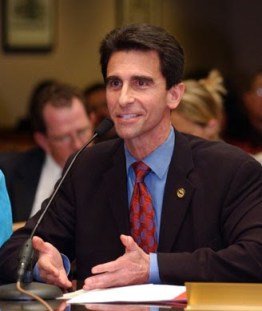
We’ve talked about this bill before; how amazing it would have been to see people like us in the pages of our history books, or to even be allowed to know that those people existed. Openly gay senator Mark Leno, the sponsor of the bill, has explained it like so: “This selective censorship sends the wrong message to all young people, and especially to those who do not identify as straight. We can’t tell our youth that it’s OK to be yourself and expect them to treat their peers with dignity and respect while we deny them accurate information about the historical contributions of Americans who happened to be LGBT,” he said.” Countless studies have proven that the more gays that straight people know and are familiar with, the more likely they are to empathize with their struggles and support them instead of viewing them as a threat. If kids were able to see how much of our country’s history is based on the contributions and hard work of gay as well as straight people, it could go a long way towards a generation more open and accepting of queer people than any before it.
Perhaps most surprising and most gratifying, however, is that this is all happening in California. During the Prop 8 campaign, much of the Yes on 8’s information and messaging was outright wrong – a popular lie that millions of Californians really believed was that without Prop 8, their children would be “taught homosexuality” in their schools. In actuality the language of the marriage equality legislation related only to, you know, marriage, but huge numbers of voters went to the polls sincerely unaware of that.
And we all know how that worked out. Prop 8 is still in a sort of seemingly endless legal limbo, in which it seems unlikely to last much longer but couples still can’t marry. But in the meantime, this bill – the Fair, Accurate, Inclusive and Respectful Education Act – might actually happen. Voters’ greatest fears – that marriage equality would somehow erode their own families and way of life – hasn’t come to pass, and never will. But their fear that their children might leave the public education system knowing that homosexuality exists, and that gay people are just as real as they are? That’s looking very possible right now. And that’s great. Because knowledge isn’t something we should ever be afraid of, and knowledge of their own place in history is something everyone deserves.
ADAM LAMBERT:
It seems like everyone has something to say about the J. Crew Toenail Painting Incident. Unsurprisingly, Adam Lambert’s response is spot on. “Gender confusion?” he tweeted to his nearly 1 million followers. “I don’t think it’s that deep – children should have full freedom of expression. It’s everyone else who’s confused… If society didn’t work so hard to reinforce gender role stereotypes we would have a much more well-adjusted & open-minded future generation.”
LILO, COACHELLA:
It turns out Coachella was this weekend and I didn’t get to go, but Lindsay Lohan did! I feel like huge floppy hats were really in or something.
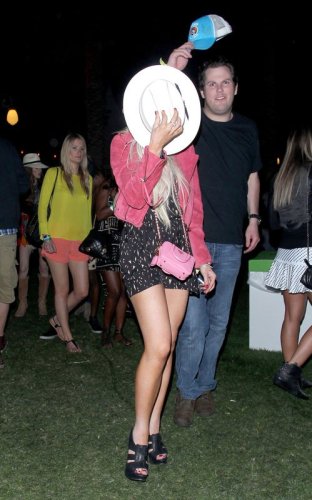
KOBE RESPONSE:
If you haven’t read gay former NBA player John Amaechi’s open letter to Kobe Bryant in response to the gay slur he used on the court last week, it’s inspiring and worth your time. “A young man from a Los Angeles public school e-mailed me. You are his idol. He is playing up, on the varsity team, he has your posters all over his room, and he hopes one day to play in college and then in the N.B.A. with you. He used to fall asleep with images of passing you the ball to sink a game-winning shot. He watched every game you played this season on television, but this week he feels less safe and less positive about himself because he stared adoringly into your face as you said the word that haunts him in school every single day.”
LADY GAGA AT NEWNOWNEXT:
Hey what did you think about Gaga’s new single, “Judas”? Well then, what about her NewNowNext Awards acceptance speech?
BISEXUAL JESUS NOVEL:
James Frey is most famous for making Oprah mad and writing a partially fabricated memoir. But now he’s writing a new book where Jesus returns to Earth as an openly bisexual man who dates a prostitute and otherwise proves himself to be the opposite of what the religious right would imagine him to be. It sounds interesting, at the very least!
MICHIGAN DOMESTIC PARTNERSHIPS:
Michigan benefits for domestic partners have so far survived a vote trying to repeal the policy. “A proposal to rescind the policy failed to receive the required two-thirds vote in the house of representatives Thursday. Sixty-six members voted in favor of repeal, eight short of the number needed. A repeal measure had passed the senate by the required margin.”
GAY BRITISH KISS-IN:
Two men at the John Snow pub in London had the worst first date ever. At first, the date was going so well that they kissed, at which point the pub kicked them out. The pub’s actions led to a kiss-in that caused the bar to close and lose a night’s revenue. The couple has a second date planned.
ANITA BRYANT:
Don’t ask me how, but I found this video of Anita Bryant being hit in the face with a pie. You’re welcome.
KITTENS:
Also, duh, kittens. #weareallmadeofkittenshadows
OTTERS:

California Textbooks Might Include Gay Role Models, History
The first gay person I ever learned about in school was Alan Turing, the computer scientist and philosopher, and it was only because one of the more offensively straight boys dressed up as him for something I’m pretty sure was called Philosophers Friday (I went as John Locke). He slicked back his hair and hit on all the other straight boys dressed as male philosophers, which everyone found hilarious. If he hadn’t, the fact that Turing had to agree to be chemically castrated to avoid prison after being charged with gross indecency and later committed suicide wouldn’t have come up, because who learns about gay people in school?
And that was in a semi-liberal Canadian high school. Same-sex marriage would have just been legalized. One of my friends took her girlfriend to prom and was very politely completely ignored by the administration. There was a Gay-Straight Alliance and people mostly left everyone in it alone.
But except for Turing and, a little while later, Oscar Wilde, gay people weren’t really talked about — or if they did, no one really mentioned that they were gay. It just wasn’t a thing. I didn’t start learning about people in history who were gay until I started reading about gay history for fun, which a lot of people don’t do. Especially if they are straight or in places (geographical or personal) where being an out gay person or reading about out gay people just doesn’t feel like an option. Or, um, if they have lives.
Right now in California, a new bill would make learning about gay and lesbian historical figures a standard. SB-48 would require that all social science textbooks include “a study of the role and contributions of lesbian, gay, bisexual and transgender Americans … to the economic, political and social development of California and the United States of America, with particular emphasis on portraying the role of these groups in contemporary society.”
One of the main goals of the bill is to reduce anti-gay bullying. In an interview with the L.A. Times, Senator Mark Leno, who introduced the bill, said:
“In light of the ongoing and ever-threatening phenomenon of bullying and the tragic result of suicides, it seems to me that better informed students might be more welcoming in their approach to differences among their classmates. Students would better understand that we are talking about a civil rights movement.”
While similar legislation was proposed in 2006, those backing the bill hope that they will be more successful with a Democrat as governor. And because California is a major textbook purchaser, publishers frequently tailor content to meet its demands, which means that other states might end up using the new materials as well. Additionally, the changes would not be forced on existing materials, but would be added in the next scheduled series of revisions, due in the next few years.
Several right-wing religious and parental groups are upset about this like it’s their job. The California Catholic Conference, the First Southern Baptist Church, and the Thousand Oaks Christian Fellowship have sent letters calling the changes “absurd.” The Concerned Parents United has published a sample letter, which I am not going to link to, arguing that including references to the sexual orientation of historical figures won’t reduce bullying because “we can teach our children to be kind to others without prompting unnecessary discussion about alternative sexual practices.” It also argues that such materials would be “indoctrination,” that “parents want their children taught academics in school — not a social agenda which may be contrary to their morals and beliefs,” and that people should be able to “opt out of being exposed to such materials” in the same (unfortunate) way they can opt out of sex education.
It’s easy, sort of but not really, to see where they’re coming from. Looking at history from more than one angle and acknowledging the validity of the non-old-dead-white-guys-in-power perspective only started to happen relatively recently. But now, it’s common academic practice. Arguing that it’s indoctrination is just silly.
And arguing that it won’t reduce bullying is just inaccurate. Last fall, teachers at a school in London claimed to have more or less eliminated anti-gay bullying after adding gay people to the history curriculum. According to the London Evening Standard,
“Music teacher Elly Barnes said she developed the lessons with colleagues five years ago, after she became concerned about pupils using “gay” as a derogatory term. […]
‘Many schools haven’t even begun to deal with homophobia,’ she said. ‘Some still think being gay is illegal in parts of the country. By looking at famous LGBT people in history, we’ve changed opinions and we have had a number of pupils come out. We have also changed the language used in the school. I used to hear the word gay used all the time as a derogatory term. Now we hardly hear it.'”
Virginia Strom-Martin, a lobbyist for the Los Angeles Unified School District, said, “We are trying to provide for those students that feel disenfranchised, some role models.”
Role models would be nice, especially ones less depressing than Turing; reducing anti-gay bullying would be even better. Last week, the proposed bill passed a party-line vote 6-3. And hopefully it will keep passing, and a generation of queer kids will finally grow up knowing that someone has been here before them to fight some of the battles.
